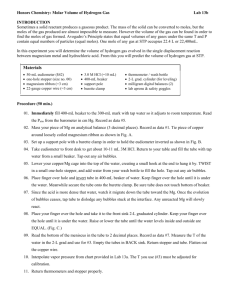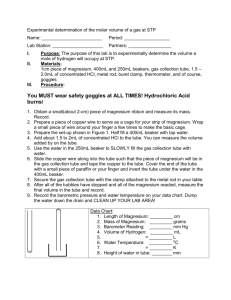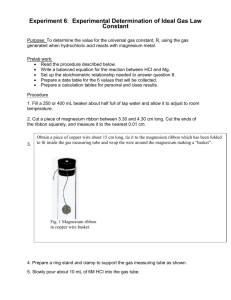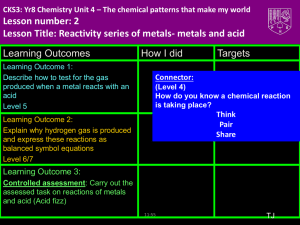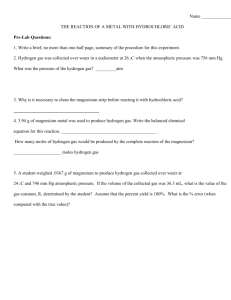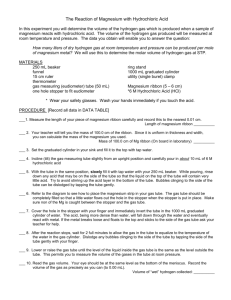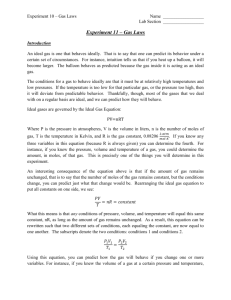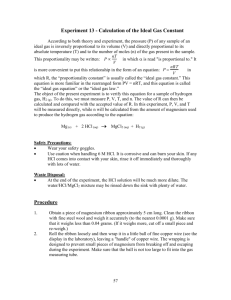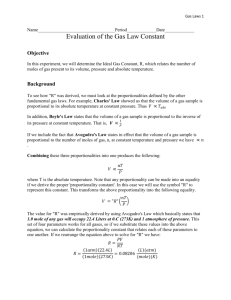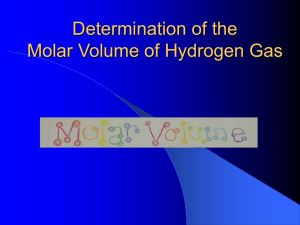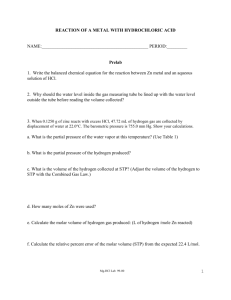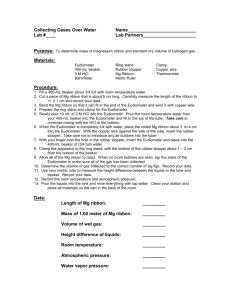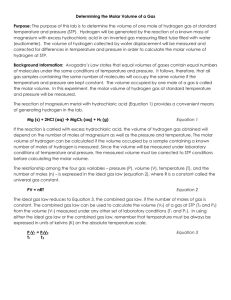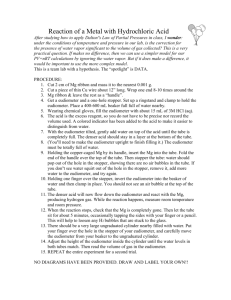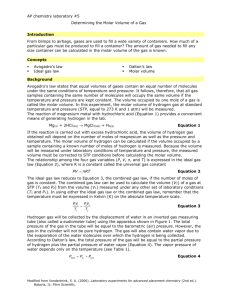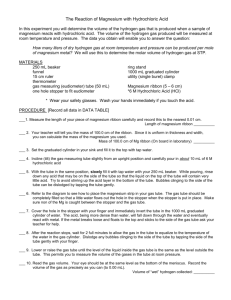Lab # 2: predicting the volume of a Gas Product
advertisement
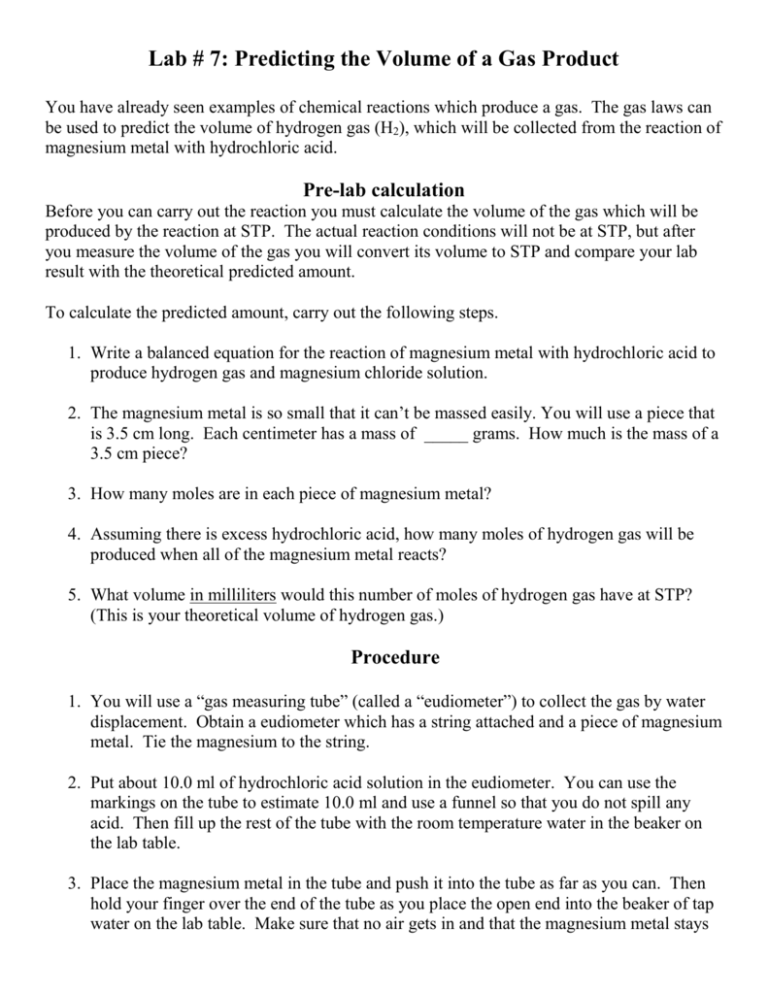
Lab # 7: Predicting the Volume of a Gas Product You have already seen examples of chemical reactions which produce a gas. The gas laws can be used to predict the volume of hydrogen gas (H2), which will be collected from the reaction of magnesium metal with hydrochloric acid. Pre-lab calculation Before you can carry out the reaction you must calculate the volume of the gas which will be produced by the reaction at STP. The actual reaction conditions will not be at STP, but after you measure the volume of the gas you will convert its volume to STP and compare your lab result with the theoretical predicted amount. To calculate the predicted amount, carry out the following steps. 1. Write a balanced equation for the reaction of magnesium metal with hydrochloric acid to produce hydrogen gas and magnesium chloride solution. 2. The magnesium metal is so small that it can’t be massed easily. You will use a piece that is 3.5 cm long. Each centimeter has a mass of _____ grams. How much is the mass of a 3.5 cm piece? 3. How many moles are in each piece of magnesium metal? 4. Assuming there is excess hydrochloric acid, how many moles of hydrogen gas will be produced when all of the magnesium metal reacts? 5. What volume in milliliters would this number of moles of hydrogen gas have at STP? (This is your theoretical volume of hydrogen gas.) Procedure 1. You will use a “gas measuring tube” (called a “eudiometer”) to collect the gas by water displacement. Obtain a eudiometer which has a string attached and a piece of magnesium metal. Tie the magnesium to the string. 2. Put about 10.0 ml of hydrochloric acid solution in the eudiometer. You can use the markings on the tube to estimate 10.0 ml and use a funnel so that you do not spill any acid. Then fill up the rest of the tube with the room temperature water in the beaker on the lab table. 3. Place the magnesium metal in the tube and push it into the tube as far as you can. Then hold your finger over the end of the tube as you place the open end into the beaker of tap water on the lab table. Make sure that no air gets in and that the magnesium metal stays up in the tube. Clamp the tube to a ring stand so that you don’t have to hold it but make sure the tube bottom is off the beaker bottom 4. After a little while the acid will fall through the tube and react with the magnesium metal. The hydrogen gas which is produced will burble up into the tube. While you are waiting for this reaction measure and record the room air pressure from the barometer and the temperature of the water in the beaker. Record the water vapor pressure for that temperature from the table on page A-17 in the appendix of your book. 5. When the reaction is complete, and all of the magnesium has reacted, you will read the volume of the gas that has been collected. You must first hold the tube so that the water level inside the tube is equal to the level outside the tube. If you can’t get the water levels equal in the beaker than transfer the tube to a tall cylinder. When the levels are equal measure and record the volume of the gas. Then release the hydrogen gas and return the eudiometer tube. Follow-up Questions 1. Before converting the volume of the hydrogen to STP, first find the pressure of the hydrogen gas that was in the tube. The total pressure in the tube came from both hydrogen gas and water vapor. This total pressure is equal to the room air pressure. To get the pressure of the hydrogen gas, subtract the water vapor pressure from the room barometric pressure. This is the initial pressure of the “dry” hydrogen gas. 2. You will now covert that volume of hydrogen to a volume at STP. Use the combined gas law. The initial volume of the hydrogen is the measured volume, the initial temperature would equal the temperature of the water, the initial pressure is the pressure you determined in step 1. What are the conditions of STP? Use these as the second temperature and pressure then find the volume. 3. How does the lab volume of hydrogen at STP compare the theoretical calculated volume? Find you percentage yield and explain any sources of error in your conclusion. 4. Why must the water levels be equal in the tube and beaker before measuring the volume of the hydrogen in the tube? If the level of the water in the tube were higher than the level of water in the beaker how would that affect the results?
